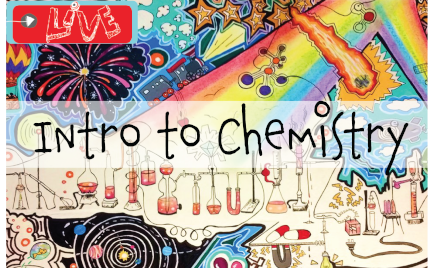Welcome to Chemistry for Homeschool: Course, Curriculum, and Live Teacher.

Our live online Chemistry for Homeschool Course, Curriculum and Live Teacher is the perfect first science class for your learner!
The course follows a custom, online chemistry for homeschool curriculum designed to make learning science fun. We’ll emphasize organizational skills and gain confidence learning about the periodic table (with a funny song), chemical reactions, and experiments.
We’ll use analogies that relate to everyday concepts that everybody can understand. A key difference with other chemistry courses is that we’ve removed most of the annoying math, technical jargon, and complicated chemicals. We’ll focus on developing strong fundamentals that will serve you in future science classes.
Learn about how brain science (neuroscience) relates to learning chemistry for homeschoolers. Learn to learn the easy way!
A core lesson about “reading” the periodic table to understand atoms, elements, subatomic particles, protons, electrons, valence electrons, neutrons, charge, atomic number, mass, atomic structure, metals, transition metals, and periodic trends. We’ll learn about the differences between pure, neutral elements and their impure, non-neutral forms, known as ions.
We’ll explore the neutron further, leading to the understanding of isotopes. We will learn about the concept of averages in science, and specifically average mass (the mass number, or atomic mass) on the periodic table.
We will learn about electron configurations, Aufbau diagrams, electron spin, the Pauli exclusion principle, Hund’s Rule, quantum numbers, the octet rule for ions, and simple binary ionic compounds, commonly known as the salts and minerals found on Earth.
We will learn to draw molecules (it’s fun), using dot diagrams and Lewis structures. We will learn about the octet rule for neutral nonmetal atoms, sigma bonds, pi bonds, single bonds, double bonds, and triple bonds.
We will learn about polarity for neutral molecules. There is a hands-on experiment to observe the 3D shapes of molecules (VSEPR theory). This optional activity is Dr. Scott’s personal favorite experiment.
We will learn about acids, bases, and the reactions between them, known as a neutralization reaction. We will learn about Arrhenius acids, Arrhenius bases, organic acids, and monoprotic acids, diprotic acids, and triprotic acids.
Will will learn about the states of matter (solid, liquid, gas, and also aqueous solutions). We will discuss solubility, dissolution, and precipitation reactions, in which a solid appears out of a solution. There’s a lab demo video with a dramatic reaction… and a decent joke too.
We will learn about redox reactions for the transition metals, reduction half reactions, oxidation half reactions, reducing agents, oxidizing agents, and electron transfer. We will learn how redox relates to biochemistry, electrochemistry, and metals reacting with acid.
We will learn about moles (mol), the fundamental unit for chemicals. The idea will extent to mole ratios for which chemicals react, formally known as stoichiometry.
We will learn about molar mass, also known as molecular weight. This key concepts allows us to measure chemicals in a lab to perform experiments with correct mole ratios. We will learn to apply precision and rounding to measurements and stoichiometric ratios.
We will put it all together for a scientific experiment featuring an acid base reaction that generates gas. There’s a big emphasis on the safety of experiments from the perspective of professional scientists, so that learners are prepared for future lab work. Learners will make a report and optionally repeat the experiment at home as the final course project.
Homeschoolers should get started with our Intro to Chemistry course, which is the first course in our multi-year sequence of online chemistry courses. It’s the course described on this page, and you can think of it as a pre chemistry course. The follow-up courses are linked below.
Intro to Chemistry is followed by First Semester Chemistry. Advanced chemistry courses include Second Semester Chemistry.
Hi, I’m Dr. Scott, the course instructor and author of the digital textbook that you get with the course.
I’m a former college chemistry professor that knows how to make learning science fun and easy. I spent waaay too many years watching students fail “hard” college science courses because they didn’t get the fundamentals.
My courses will show you how to learn science, and I guarantee they’ll prepare you for future science classes. The easy way.

Live on Zoom: Yes, meets live online weekly.
Videos Included: The video textbook has 185 videos (25 hours total) including complete chemistry lessons, detailed worksheet solutions, several lab demos, a full experiment you can easily and safely repeat at home, and instructions to make a lab report as a final project.
Materials Included: The course has 36 printable pdf files including worksheets, answer keys, and class notes.
Time commitment: Learners typically spend 2-4 hours per week, which includes combined live in-class time and out-of-class time.
Course duration: There are 12 lessons, and we cover a lesson about every week of live classes, meeting live twice per week.
Instructor Support Included: Dr. Scott teaches the live class personally. He is available for questions and evaluates worksheets by email. There are grades and a certificate of completion at the end.
Learners completing Chemistry for Homeschool: Course, Curriculum, and Live Teacher will be able to:
Read the periodic table.
Understand chemical bonding.
Write chemical reactions.
Conduct a laboratory experiment.
Record and report experimental data.
Confidently approach science.
Get credit for homeschool.